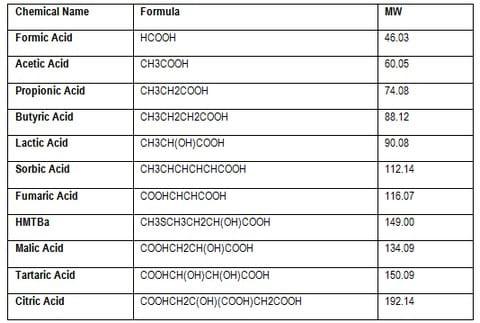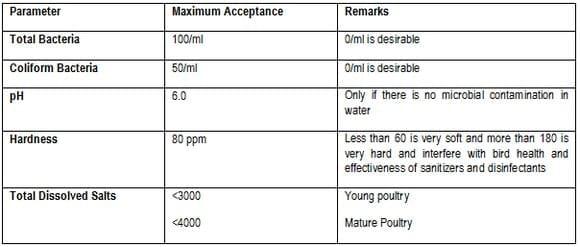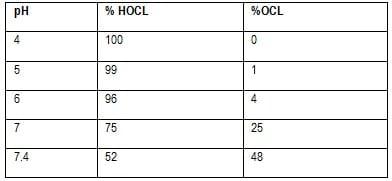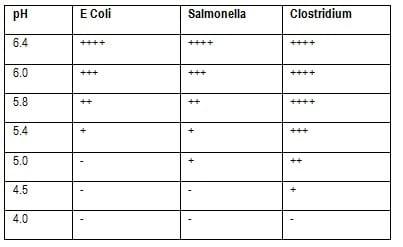Organic acids in feed and water supplies for poultry
Practical Applications of Formaldehyde and Organic Acids in Control of Enteric Pathogens in Feed and Drinking Water
Published: August 23, 2011
By: Dr. Anas Ahmad Khan (Novus International Pakistan)
Introduction
Intestinal colonization and shedding of pathogenic bacteria in animal feces is an important issue in both human food safety and animal health. Animal feed due to its composition provides a favorable environment for the growth of various microorganisms. Microorganisms found in feedstuffs can be saprophytic, pathogenic, conditionally pathogenic and toxic. Their proliferation and growth in the feed depends on various factors, such as moisture, temperature, type of feed, aerobic and anaerobic conditions, chemical and physical properties of raw material, feed pH values, presence of feed supplements, storage periods and conditions as well as feed decomposition products (4).
Horizontal transmission of microorganisms, particularly through contaminated drinking water seems to be a potential source of infection or re-infection among chickens in the flocks because most of the potentially pathogenic microbes can survive in drinking water for a long period of time (6, 14, 18).
Achievable strategies for the reduction in colonization and shedding of pathogenic microorganisms such as E Coli, Salmonella, Clostridium and Campylobacter must involve interventions at multiple points from the farm to the table. Different methods have been used to reduce the risk of pathogens on the farm such as drug therapy and vaccination, competitive exclusion and drug therapy and competitive exclusion (20, 21, 22, 24).
Formaldehyde has been assessed as an effective antimicrobial feed additive particularly against E coli, Salmonella and Clostridium. It is recommended for all species and growth periods in livestock. Formaldehyde treatment of feeds has also been reported to have bactericidal effects without apparent loss of palatability or growth reduction in poultry and other food animals (2, 5, 10, 17, 23). Other agents such as organic acids (as in particular propionic acid) have been used for decades in feed preservation, protecting feed from microbial and fungal destruction and treatment of feed with organic acid has been shown to have the potential to reduce infection level of Salmonella in feed and poultry (1, 11, 12, 13, 15, 16, 19).
Organic acids have become useful in lowering microbial counts in drinking water and feed by virtue of acidification and direct killing effect (3). The use of formic acid and propionic acid in combination with 2-hydroxy 4-methyl thio butanoic acid (HMTBa) in drinking water and feed have proven to be a practical and efficacious farm intervention to reduce the incidence, colonization and shedding of E coli, Salmonella and Campylobacter in poultry (7, 12). Reduced levels of pathogenic microorganisms in the intestine mean fewer microorganisms to be spread in the environment of the chicken house and therefore less contaminated final product. They are also safer to use in terms of lower capacity to be corrosive in the waterlines. Through strategic use of organic acids in the water, the gut will face lesser bacterial-induced enteritis and therefore will be able to absorb the nutrients better.
Organic Acids - Chemical Nature:
In definition, organic acids are those organic molecules which contains carbon chains (R-) along with a carboxyl group (-COOH) in their chemical structures. There is a variety of chemical compounds in the broad family of organic acids but few of them are of prime importance in poultry health and nutrition. Bactericidal and growth promoting effect of short chain (C1-C7) have been well reported in literature (8). Following table shows the chemical properties of some organic acids of interest in animal health and nutrition.

Practical Applications of Organic Acids:
Improvement of Water Quality
- Water Acidification and Sanitization
- Removal of Biofilms from Water Lines
Water is a major biological ingredient and is vital for many essential physiological functions for animals. It facilitates the digestion and absorption of nutrients, regulates the enzymatic functions of body, regulates the body temperature, lubricates the joints and organs, eliminates waste products from body and also an essential component of blood and body tissues. Chicken consumes about twice as much water as feed and this ratio becomes higher during hot climatic conditions. At the time of hatching water constitutes approximately 85% of the chick´s weight and in mature birds it is almost 70% of total body weight. Reduction in water intake has a significant effect on the life of chicken as it has many essential roles in the health and performance of poultry. Adequate supply of clean water is vital for poultry to get the optimal performance (Arbor Acre Update: Water Quality, February 2008). Regular assessment of water quality has a critical role in modern farming systems and monitoring of microbial load, mineral content, carbonate hardness, salinity and nitrate levels is necessary prior to chick placement. Regular sampling of waters from main storage tank and at various nipple or bell drinker level must be done and contamination must be avoided during the sampling. Following table shows the drinking water quality standards for poultry.

As an essential component and nutrient of body, water acts as a best vehicle for most of the pathogenic bacteria for poultry which include Salmonella, E. coli, Campylobacter and Clostridium. Generally the elimination of water borne bacteria is very difficult as they are encased in a compact cell wall and many detergents and disinfectants cannot degrade the bacterial cell wall. Additional protection comes from the development of biofilms in water tanks and lines which makes the elimination of pathogens more difficult. These enteric pathogens remain within the GUT of chicken for a long time and compete for the nutrients and hinder the growth and performance of poultry.
Chlorination of water is the most commonly used method for the sanitization of drinking water for poultry. At high pH of water chlorine remains only in the form of chloric ions that has very minimum sanitizing activity. For strong sanitizing activity only hypochlorus ions are required which is only possible at acidic pH. Following table shows the ratio of hypochlorus to chloric ions at different levels of pH.

Most of the water borne microorganisms have tendency to produce biofilms within the drinking water systems to get an additional protection. These biofilms are basically the complex aggregations of polysaccharides and are solid in substrate. Cleaning and flushing of water lines and system with hydrogen peroxide is a common practice but if the hardness of water is more than 180 ppm, reformation of biofilms within a short period of time is likely. In such circumstances the repeated treatments with higher concentrations of hydrogen peroxide are recommended which is not economically viable and also corrosive to drinking systems.
Organic acids have been found to be efficacious in lowering the pH of drinking water and thus don´t allow the pathogenic microorganisms to grow in the water. Most of the water borne enteric pathogens cannot grow at lower pH like 4, so with the acidification effect of organic acid a variety of pathogens can be controlled easily and continuous use of organic acids also eliminates the biofilms. Following table shows the effect of different levels of pH on the growth of various bacteria.

Antimicrobial Spectrum
- Control of E. Coli, Salmonella, Clostridia
- Prevention of Necrotic Enteritis
Enteric pathogens like Salmonella, E. coli and Campylobacter create a negative environment at intestinal level. Chicken take up these pathogens from contaminated water and feed and they first become colonize in the proximal digestive tract of birds and after that travel to intestines via peristaltic movements. With the acidification of water and feed with organic acids there has been a strong acidification effect of proximal digestive tract which stops the introduction of pathogenic microorganisms in GUT.
For microorganisms organic acids can act as a source of carbon and energy as well as inhibitory agents and this action depends upon the concentration of organic acid, its ability to enter the bacterial cell and capacity of microorganism to metabolize the organic acid. Non dissociated form of organic acids is lipophillic in nature and it can only enter the bacterial cells. Once it enters the bacterial cell, due to neutral pH of bacterial cytoplasm it readily converts into dissociated form and releases H+ and A- ions which reduces the cellular pH of bacterial cell.
The lowering of pH disrupts the enzymatic reaction and nutrient transportation system of bacteria. A specific H+ ATPase pump tries to bring this pH to neutral level which is an energy dependant mechanism and results in the depletion of energy within bacterial cell. Decarboxylases and Catalases are the target enzymes of organic acids and their inhibition finally disrupt the glycolysis of bacteria and anion portion of organic acid becomes toxic inside the cell and cause anionic and internal osmotic imbalance and bacteriostasis is the final consequence.
Necrotic enteritis is a widespread problem of broiler industry around the world and it has been no longer considered as a disease and still is a neglected problem. Outbreaks of subclinical enteritis are sporadic in nature and poor weight gain and impaired FCR at the time of slaughter are negative consequences of enteritis. It has a critical economic impact on broiler industry and losses may be estimated as 4 rupees per bird. The causative agent Clostridium perfringens rears in deep litter and is critical for layers and breeders during feed restriction time when these birds eat litter. This organism is also a normal inhabitant of intestinal tract and lives harmlessly in the lower part of GUT. Normal number in intestine is 104 cfu/g of digesta but any disturbance in the normal microflora causes rapid proliferation of perfringens and number may exceeds to 109 cfu/g of digesta. Antibiotic growth promoters are extensively use to control necrotic enteritis in poultry and at very low inclusion levels their efficacy is considered as unreliable and questionable. Moreover, the drug resistance to zinc bacitracin, virginiamycin, lincomycin, enramycin and tetracycline is well reported and documented (9,25).
Growth Promoting Effects
- GUT Environment Modification
- Alternatives to Antibiotic Growth Promoters
Good intestinal health and perfect consistency of ping is an important indicator of health of chickens. The GUT microbial ecosystem of chicken contains more than 2000 species of microorganisms which act as a barrier to colonization of pathogenic bacteria. Within GUT beneficial and pathogenic bacteria competes for essential nutrients, space and intestinal attachment sites. The goal of a successful GUT environment modification program is to create an environment which is beneficial for normal microflora and detrimental to colonization by enteric pathogens. Most of the organic acids are considered as best for GUT environment modifications.
Low levels of dietary antibiotic growth promoters lead to drug resistance against certain enteric pathogenic bacteria and due to their residual effect in eggs and meat their use has been banned in poultry feeds in EU (25). The selection of a real alternative to antibiotic growth promoters has become a challenge for researchers and scientists. Organic acids have been identified as best alternative to antibiotic growth promoters as they act like AGPs and control the enteric pathogens which compete for essential nutrients with GUT microflora. Other beneficial effects of organic acids include improvement in digestive enzymes activity, microbial phytase activity, reduction in small intestine pH and increased growth of intestinal mucosa.
Literature Cited:
1. Berchieri, A. and Barrow, P.A. (1996) Reduction in incidence of experimental fowl typhoid by incorporation of a commercial formic acid preparation (Bio-Add) into poultry feed. Poultry Science, 75: 339-341
2. Bugarski, D., Handzic, R., Sivcevic, A. and Stanic, I. (1990) Effect of feeding regime and formaldehyde-treated soybean on the productivity of dairy cows. Veterinaria Sarajevo, 39: 21-30
3. Byrd, J. A., Hargis, B. M., Caldwell, D. J., Bailey, R. H., Herron, K. L., McReynolds, J. L., Brewer, R. L., Anderson R. C., Bischoff K. M., Callaway T. R., and Kubena, L. F. (2001) Effect of lactic acid administration in the drinking water during pre-slaughter feed withdrawal on Salmonella and Campylobacter contamination of broilers. Poultry Science, 80: 278-283
4. Cabarkapa, I., Kokic, B., Plavsic, D., Ivanov, D., and Levic, J. (2009) Microbiological safety of animal feeds. Biotechnology in Animal Husbandry, 25(5-6): 1156-1166
5. Carrique-Mas, J. J., Bedford, S., and Davies, R. H. (2007) Organic acid and formaldehyde treatment of animal feeds to control Salmonella: efficacy and masking during culture. Journal of Applied Microbiology, 103: 88-96
6. Chaveerach, P., Keuzenkamp, D. A., Limpan, L. J. A., and Van Knapen, F. (2004) Effect of organic acids in drinking water for young broilers on Campylobacter infection, volatile fatty acid production, Gut microflora and histological cell changes. Poultry Science, 83: 330-334
7. Cox N. A., McHan F., and Bailey, J. S. (1994) Effect of butyric or lactic acid on the in vivo colonization of Salmonella typhimurium. Journal of Applied Poultry Research, 3: 314-318
8. Dibner, J. J. and Buttin, R. J. (2002) Use of organic acids as a model to study the impact of Gut microflora in nutrition and metabolism. Journal of Applied Poultry Research, 11: 453-463
9. Dibner, J. J. and Richards, J. D. (2005) Antibiotic growth promoters in agriculture: history and mode of action. Poultry Science, 84:634-643
10. Duncan, M.S. and Adams, A.W. (1972) Effects of a chemical additive and of formaldehyde-gas fumigation on Salmonella in poultry feeds. Poultry Science, 51: 797-802
11. Hinton, M., Linton, A.H. and Perry, F.G. (1985) Control of salmonella by acid disinfection of chicks´ food. Veterinary Records, 116: 502
12. Hinton, M. and Linton, A. H. (1988) Control of Salmonella infections in broiler chickens by the acid treatment of their feed. Veterinary Record, 123: 416-421
13. Iba, A.M. and Berchieri, A. (1995) Studies on the use of a formic acid-propionic acid mixture (Bio-add) to control experimental Salmonella infection in broiler chickens. Avian Pathology, 24: 303-311
14. Kazwala, R. R., J. D. Collins, J. Hannan, R. A. Crinion, and O´ Mahony, H. (1990) Factors responsible for the introduction and spread of Campylobacter jejuni infection in commercial poultry production. Veterinary Records, 126: 305-306
15. Khan, M. and Katamay, M. (1969) Antagonistic effect of fatty acids against Salmonella in meat and bone meal. AppliedMicrobiology, 17: 402-404
16. Matlho, G., Himathongkham, S., Riemann, H. and Kass, P. (1997) Destruction of Salmonella Enteritidis in poultry feed by combination of heat and propionic acid. Avian Diseases, 41: 58-61
17. McAllister, T., Beauchemin, K., McClelland, L. and Cheng, K. (1992) Effect of formaldehyde-treated barley or escape protein on nutrient digestibility, growth and carcass traits of feedlot lambs. Canadian Journal of Animal Science, 72: 309-316
18. Pearson, A. D., M. Greenwood, T. D. Healing, D. Rollins, M. Shahamat, J. Donaldson, and Colwell, R. R. (1993) Colonization of broiler chickens by waterborne Campylobacter jejuni. Journal of Applied and Environmental Microbiology, 59: 987-996
19. Rouse, J., Rolow, A. and Nelson, C.E. (1988) Effect of chemical treatment of poultry feed on survival of Salmonella. PoultryScience, 67: 1225-1228
20. Salvat, G., Lalande, F., Humbert, F., and Lahellec, C. (1992) Use of a competitive exclusion product to prevent Salmonella colonization of newly hatched chicks. International Journal of Food and Microbiology, 15:307-311
21. Stavric, S. (1987) Microbial colonization control of chicken intestine using defined cultures. Food Technology, 41:93-98
22. Stavric, S. (1992) Defined cultures and prospects. International Journal of Food and Microbiology, 15:245-263
23. Vanderwal, P. (1979) Salmonella control of feedstuffs by pelleting or acid treatment. World Poultry Science Journal, 35: 70-78
24. White, P. L., Baker, A. R., and James, W. O. (1997) Strategies to control Salmonella and Campylobacter in raw poultry products. OIE Scientific and Technical Review, 16:525-542
25. Yang, P., Iji, P.A., and Choct, M. (2007) Effects of different dietary levels of mannan oligosaccharide on growth performance and gut development of broiler chickens. Asian Australian Journal of Animal Science, 20: 1084-1091
Related topics:
Authors:
Recommend
Comment
Share
Javaneh khorasan
21 de septiembre de 2011
results of organic acids using depends on organic acids composition and percentage of acids in final product
Recommend
Reply
Vetworks
22 de junio de 2013
Which one is the better option sir ! Acidification of water or acidification of feed? How often is it good to do acidification? Please suggest me a schedule.
Recommend
Reply
23 de enero de 2012
good combination of organic acids especially propionic and formic with formaldehyde give nice results to
control enteric pathogens > i used it as product call formycine 1-1.5 kg /ton in breeder broiler and layers feed
but you must know that it may affect on some live water administrated vaccines >
Thank you all
Recommend
Reply
21 de septiembre de 2011
Enteric poultry is great treat to poultry industry nowadays, therefore, more discussion about the is very essential to understand deeper the root-cause of the problem and its solution. thank you very much.
Recommend
Reply
Recommend
Reply
30 de agosto de 2011
Dear All,
We have conducted the Field study on " Efficacy of Short Chain fatty acids(Organic Acids) on Water Quality".
Under this program, we have collected around 200 Water samples from different sources(farms) and localities( Area). It was found that deep bore well water has more PH and hardness and required more doses of organic acid to bring the PH of water below permissible limit. Also the hard water after treatment with Organic acid shows less PH stability at room temperature so its need to consume the same ASAP.
Else Organic Acid specially Acetic acid is the best remedy to control the harmful micro flora in drinking water.
Lots of thanks to Author to compile the literature on Organic acids with effective manner.
Regards,
Dr Jaydip
Recommend
Reply


Lost in the Market Uncertainty Caused by the Outbreak
Suggested link
29 de agosto de 2011
The organic acids will work very well in controlling the gram negative gut pathogens only in the acidic pH of Proventriculus and Gizzard as the acids are in undissociated form here. Where as at neutral pH prevailing at crop and Intestine, the acids are in dissociated form and there by unable to penetrate into the bacterial cell and subsequently there won't be any bactericidal activity.
The efficacy of the organic acids will depend on the following factors
1. Acids used and its synergistic combinations
2. Dosage (breeding and laying diets will require more dosage when compare to chick and grower diets)
3. Type of Pathogens
4. Pathogen Load
Recommend
Reply
Montajat Veterinary Pharmaceuticals Co. Ltd.
27 de agosto de 2011
Quite surprising article on Formaldehyde to be used orally.
Recommend
Reply
27 de agosto de 2011
we have seen great results after using organic acids and formaldehyde in broilers and layers.of course the best result was after using organic acids + probiotics or + phytobiotics which has no side effect and also are not carcinogen . I am waiting for texts about probiotics and phytobiotics to. Thank you very much for your search. good luck
Recommend
Reply

26 de agosto de 2011
Article is good but I agree with Dr Farooks opinion , Use of organic acids is far better than formaldehyde which is practically giving excellent results .
Recommend
Reply

Would you like to discuss another topic? Create a new post to engage with experts in the community.

















